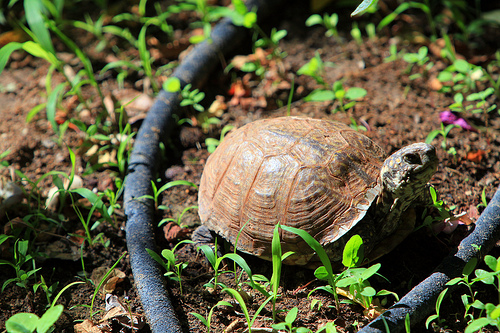Looking for facts about Tortoises? Then look no further, here’s our list of the best and most important facts about such a great species:
List of Tortoise Facts
- There are many different species of tortoise from the Mediterranean tortoises that hibernate to the Tropical species, which do not
- Many of these tortoise living in this country day were brought in before the ban
- Tortoise living in our climate require extra light and heat from a basking lamp
- Thankfully these species were banned from importation in the seventies
- As many as 6 eggs are laid twice a year
- Hatchling can be hibernated for a short period – by experienced owners
- Tortoises are cold blooded reptiles
- The tortoise should be allow to have access to an outdoor garden
- Food such as dog food, bread, milk, cereal and tin fruit has been given to tortoises in the past with detrimental affects – causing lumpy shell, overweight and many internal problems
- Different species/sexes of tortoise should be housed separately
- In captivity the most common methods are Box or Fridge method
- They need the warmth from the sun to warm their blood
- Ideal temperatures for hibernation are 5-6 C
- One of the two main parts of a tortoises diet is fibre, the secondly calcium
- The life span can be 100 years and more
- As we need food for energy, they need the sun
- They require the UV rays from the sun and turn this into vitamin D
- Weeds – Dandelions, clover, sow thistle and plantain are best offered
- Vitamin injections should not be given unless there is a genuine vitamin deficiency
- Freezing temperatures can cause blindness or be fatal
- Adult tortoises hibernate for four months of the year normally from November – February
- The sex of the hatchling is determined by the temperature in which the egg is incubated
- If you require any help or assistance, please contact us, we are happy to help
- Owners should weigh and measure their tortoises regularly
- In the wild they would bury themselves into the ground
- Not all tortoises hibernate naturally – depending on the species
- By Mediterranean tortoises we refer to the Spur thighed and Herman’s
- A basking lamp is a reflector lamp – not a heat lamp
- Once they are warm, they can eat and digest food
- Mediterranean tortoise are the most common tortoises living in this country
- There are many captive breeding programmes in the country at present
- Hatchling are normally kept in a vivarium for the first two years
- Temperatures of up to 90 F are required depending on the species
- Only healthy tortoises should be hibernated
- Hatchling are as independent as adult tortoises
- Tortoise produce egg and bury them in the ground
